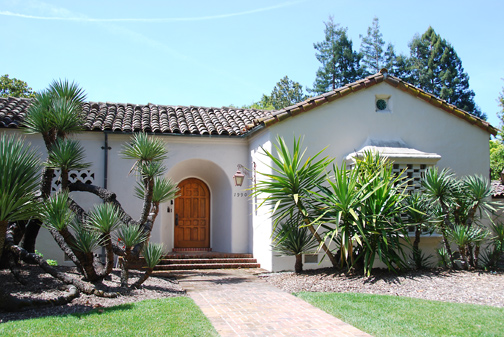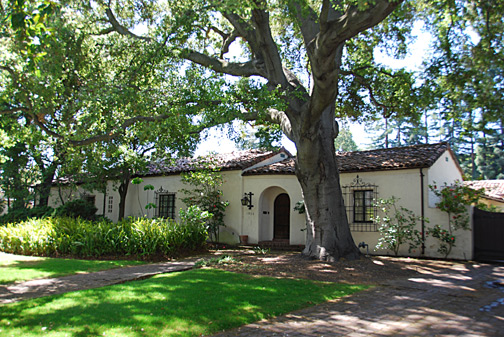 Palo Alto Stanford Heritage
Palo Alto Stanford Heritage 
1990 Cowper Street

1950 Cowper Street
Birge Clark is said to be "Palo Alto's best-loved architect." Lucie Stern, for whom he designed 1990 and 1950 Cowper Street, is often called Palo Alto’s “fairy godmother.” The two met during the depression in December 1931 when Clark was hired to redesign the entry steps to Stern’s Atherton house. Soon, Clark was finding two vacant lots on Cowper Street for her and drafting the plans for two 4,000 square foot houses, one for Lucie at 1990 and one at 1950 for her disabled daughter, Ruth. This led to a long and productive relationship between them and to Stern’s donation of $400,000 pre–inflation dollars to a dozen civic projects in Palo Alto.
Lucie Stern (1871–1946) was born Lucie Cahen in French Lorraine but grew up from age three in San Francisco. With her 1899 society wedding to Louis Stern, the middle class Lucie joined one of the wealthiest families on the West Coast. The three Stern brothers were the nephews and heirs of bachelor Levi Strauss, the originator of Levi overalls. Louis’ position as treasurer of Levi Strauss and Stern Company required the couple to move to New York for several years.
While there, Stern bore four children, losing her eldest daughter and son in infancy. After the family moved back to San Francisco following the Great Earthquake of 1906, a second daughter died at age five from pneumonia. Later, the family built a mansion called Byde–A–Whyle on Selby Lane in Atherton. Here at age 12, Stern’s youngest child, Ruth, began having seizures that permanently stunted her mental growth. By 1924, Louis Stern died and, ultimately, the three Stern brothers’ widows became the sole owners of Levi Strauss.
Stern’s personal tragedies were great but alleviated somewhat by her relationship with Clark from 1931 until her death in 1946. In his memoir, Clark notes "her pleasure in building, her desire to provide more employment for various mechanics with whom she had become acquainted" and "her delight in doing things for people…."
Clark built hundreds of buildings in Palo Alto and at Stanford but is best known for his California Colonial Revival style. Together, 1990 and 1950 demonstrate Clark’s fondness for large expanses of wall, carefully irregular fenestration and embellishments of colored tiles and wrought iron. He considered Mrs. Stern’s house at 1990 to be “one of his best” and an “ideal solution for a one-story California Colonial house.”
From the entry hall, with its flat–beamed ceiling, one looks through an arch to the living room with a cathedral beamed ceiling and, then, a second elliptical arch leads to the dining room with a groined ceiling. Each arch and ceiling seems carefully calibrated for maximum effect in height and type. The living room, dining room, breakfast room, kitchen, and master and guest bedrooms constitute one wing, while another is for the servants’ quarters. A large cloister opens from the living room between the two wings to an outdoor area, conducive to family gatherings and entertainment. Ruth’s house at 1950, although of a similar plan, did not have the kitchen amenities needed at Lucie’s house for Eugene, the chef who cooked for everyone. A Secret Garden, landscaped by Les Kiler, lay between the two houses and had a fountain paved with hundreds of flat rocks personally collected by Kiler at Pescadero Beach. The remaining walkways, including the driveway, were brick.
A unique feature demanded by Lucie for the front part of her house was a large gift closet. Clark notes that while “It soon became apparent to us that Mrs. Stern did not particularly like women,” she invited hundreds of male students and faculty to Sunday dinner. The meals and bull sessions attended by “Aunt Lucie’s boys” were followed by forays into her “gift closet” stocked with Levi Strauss clothing, which she distributed to her guests. To be fair to Lucie, she did keep a supply of silk stockings should one of her boys bring a lady friend.
For all her personal generosity and philanthropy, Lucie was a shy woman who shunned publicity. Her wealth and name could have made her the doyenne of San Francisco society. “I simply don’t like that society life” she said. Palo Alto is fortunate that she preferred a small, university town. ©
PAST, September 27, 2013
E-mail us at either webmaster@pastheritage.org or president@pastheritage.org.
![]() Palo Alto Stanford Heritage—Dedicated to the preservation of Palo Alto's historic buildings.
Palo Alto Stanford Heritage—Dedicated to the preservation of Palo Alto's historic buildings.
Copyright © 2015 Palo Alto Stanford Heritage. All rights reserved.